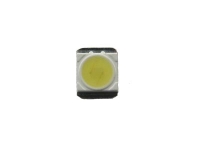I warmly welcome my TV professors here.
I got an LG LED TV (for some).
- LGP3739-13PL1 power supply,
- HC390DUN-VCFP1-21XX matrix
I would like to fix it, but after measuring and replacing the electrolytes in the power supply, I came to the conclusion that everything is ok. Voltage is correct. I dismantled the matrix and it turns out that 6 burned LEDs burned in different rows of LED strips - all connected in series.
After exchanging 6 broken for other not original but strong leds, it affected the eye. 20 min
I disassembled the matrix again ... it turned out that 4 others fell.
Without waiting and exchanging another 2 or 4 years warmed up, I ordered the original on one of the leds portals.
LED MATRIX LED - LG 3528/2835 - 3V - 1W
I desoldered (with a hot air heat gun), removed all the "old" ones and replaced them with new ones (carefully and quickly so as not to overheat the led - salomon soldering iron)
After switching the TV on, it worked for 5 minutes and 3 LEDs burned out, after soldering new ones, it turned out that the next LED is burning, the black dot is burning, the smoke is on, I turned off the TV. The voltage at the connection plug led supply was 121V ÷ 36 diodes = 3.36V per unit.
Then the voltage dropped to 119V.
But why did I have 134V on old diodes? Then it dropped to 121V and shone less (automatic light intensity control worked)
I read something about plug-in bulbs I had 120V on a 40W bulb.
My nice professors what to do because I spent over PLN 80 on leds, new items or can you somehow change the LED backlight driver to reduce the voltage, give it to yourself and buy new led strips, but I don't want to have drugs because after 2/4 years they fall so I wanted to solder new or new strips.
what to do because I spent over PLN 80 on leds, new items or can you somehow change the LED backlight driver to reduce the voltage, give it to yourself and buy new led strips, but I don't want to have drugs because after 2/4 years they fall so I wanted to solder new or new strips.
Hmm or I still have some fault in the LED power supply - where to start? Because I will order new ones and they will also fall.
Because I will order new ones and they will also fall.
I am asking for an answer or advice - thank you in advance - I greet Damiano from Katowice as usual.
I got an LG LED TV (for some).
- LGP3739-13PL1 power supply,
- HC390DUN-VCFP1-21XX matrix
I would like to fix it, but after measuring and replacing the electrolytes in the power supply, I came to the conclusion that everything is ok. Voltage is correct. I dismantled the matrix and it turns out that 6 burned LEDs burned in different rows of LED strips - all connected in series.
After exchanging 6 broken for other not original but strong leds, it affected the eye. 20 min
I disassembled the matrix again ... it turned out that 4 others fell.
Without waiting and exchanging another 2 or 4 years warmed up, I ordered the original on one of the leds portals.
LED MATRIX LED - LG 3528/2835 - 3V - 1W

I desoldered (with a hot air heat gun), removed all the "old" ones and replaced them with new ones (carefully and quickly so as not to overheat the led - salomon soldering iron)
After switching the TV on, it worked for 5 minutes and 3 LEDs burned out, after soldering new ones, it turned out that the next LED is burning, the black dot is burning, the smoke is on, I turned off the TV. The voltage at the connection plug led supply was 121V ÷ 36 diodes = 3.36V per unit.
Then the voltage dropped to 119V.
But why did I have 134V on old diodes? Then it dropped to 121V and shone less (automatic light intensity control worked)
I read something about plug-in bulbs I had 120V on a 40W bulb.
My nice professors
 what to do because I spent over PLN 80 on leds, new items or can you somehow change the LED backlight driver to reduce the voltage, give it to yourself and buy new led strips, but I don't want to have drugs because after 2/4 years they fall so I wanted to solder new or new strips.
what to do because I spent over PLN 80 on leds, new items or can you somehow change the LED backlight driver to reduce the voltage, give it to yourself and buy new led strips, but I don't want to have drugs because after 2/4 years they fall so I wanted to solder new or new strips. Hmm or I still have some fault in the LED power supply - where to start?
 Because I will order new ones and they will also fall.
Because I will order new ones and they will also fall. I am asking for an answer or advice - thank you in advance - I greet Damiano from Katowice as usual.



